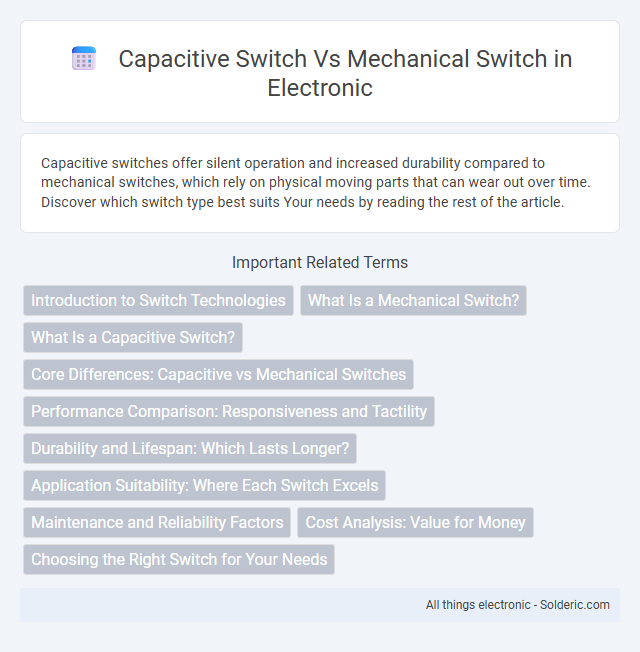Capacitive switches offer silent operation and increased durability compared to mechanical switches, which rely on physical moving parts that can wear out over time. Discover which switch type best suits Your needs by reading the rest of the article.
Comparison Table
| Feature | Capacitive Switch | Mechanical Switch |
|---|---|---|
| Operating Principle | Detects touch via change in capacitance | Physical contact between moving parts |
| Lifespan | Up to 10 million activations | Typically 5 to 50 million cycles |
| Response Time | Fast, near-instant | Moderate, depends on mechanical movement |
| Durability | Highly durable, no mechanical wear | Subject to mechanical wear and tear |
| Environmental Resistance | Resistant to dust, water (IP65+ possible) | Less resistant, prone to dirt and moisture issues |
| Feedback | Often requires haptic or audio feedback | Physical tactile feedback inherent |
| Installation Complexity | Requires sensitive electronics and calibration | Simple wiring and mechanical assembly |
| Power Consumption | Low standby power, active touch detection consumes more | Minimal power, depends on circuit design |
| Cost | Higher initial cost due to electronics | Lower cost and widely available |
Introduction to Switch Technologies
Capacitive switches detect changes in electrical capacitance caused by the proximity of a finger, offering a touch-sensitive interface without physical movement, which enhances durability and reduces wear. Mechanical switches rely on physical actuation, typically through a moving part that creates a tactile response and electrical contact, providing reliable feedback and long-established functionality in various applications. Advances in capacitive technology enable seamless integration with modern touchscreens and smart devices, while mechanical switches continue to be favored for their robust performance in demanding environments.
What Is a Mechanical Switch?
A mechanical switch uses physical moving parts to open or close an electrical circuit, providing tactile feedback when pressed. It typically consists of a spring and contacts that physically connect to register an input, making it highly reliable and durable. Understanding what a mechanical switch is can help you choose the right interface for applications requiring precise and responsive actions.
What Is a Capacitive Switch?
A capacitive switch operates by detecting changes in electrical capacitance when a finger or conductive object approaches its sensor, enabling touch-sensitive control without physical movement. Unlike mechanical switches that rely on physical button presses and moving parts, capacitive switches offer increased durability and faster response times due to their solid-state design. Your devices can benefit from the sleek, reliable functionality of capacitive switches, which are commonly used in modern touchscreens and control panels.
Core Differences: Capacitive vs Mechanical Switches
Capacitive switches detect touch through changes in the electrical field caused by the user's finger, enabling contactless activation and enhanced durability. Mechanical switches rely on physical movement and direct contact of internal components, resulting in tactile feedback and audible clicks. Capacitive switches offer faster response times and greater resistance to wear, while mechanical switches provide precise actuation favored in gaming and typing applications.
Performance Comparison: Responsiveness and Tactility
Capacitive switches offer superior responsiveness with near-instant actuation thanks to their detection of electrical changes, making them ideal for rapid input scenarios. Mechanical switches provide distinct tactility and audible feedback through physical movement, enhancing user experience for those who prefer tangible confirmation. Your choice depends on whether you prioritize speed and smoothness or physical touch and feedback in performance.
Durability and Lifespan: Which Lasts Longer?
Capacitive switches generally offer greater durability and a longer lifespan compared to mechanical switches due to their contactless operation, which reduces wear and tear. Mechanical switches rely on physical moving parts that are susceptible to degradation over time, typically lasting between 20 to 50 million actuations, while capacitive switches can exceed 100 million cycles. Your choice will depend on the required longevity and maintenance preferences, with capacitive switches favored in high-use environments.
Application Suitability: Where Each Switch Excels
Capacitive switches excel in applications requiring high durability and moisture resistance, such as industrial control panels and medical devices, due to their non-mechanical operation and sealed design. Mechanical switches are ideal for tactile feedback needs in consumer electronics and gaming equipment, offering reliable physical actuation and long lifespan under repeated use. Each switch type suits environments based on factors like user interaction, environmental conditions, and maintenance requirements.
Maintenance and Reliability Factors
Capacitive switches offer higher reliability due to their solid-state construction, eliminating mechanical wear and reducing maintenance needs over time. Mechanical switches contain physical moving parts prone to wear and tear, requiring periodic lubrication and replacement to maintain optimal performance. Your choice hinges on prioritizing long-term reliability with minimal upkeep (capacitive) versus traditional tactile feedback with more frequent maintenance (mechanical).
Cost Analysis: Value for Money
Capacitive switches typically offer higher upfront costs due to advanced sensing technology but provide durability and low maintenance, translating to long-term savings. Mechanical switches have lower initial prices but often require more frequent replacements and repairs, increasing lifetime expenses. Evaluating your specific application and usage can help determine which switch offers the best value for money.
Choosing the Right Switch for Your Needs
Choosing the right switch depends on your specific application and user experience preferences. Capacitive switches offer a sleek, touch-sensitive interface with faster response times and enhanced durability due to the lack of moving parts, making them ideal for environments requiring frequent use and easy cleaning. Mechanical switches provide tactile feedback and reliability favored in gaming or typing tasks where precise actuation and physical confirmation are crucial for performance.
Capacitive switch vs Mechanical switch Infographic

 solderic.com
solderic.com